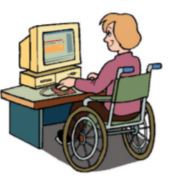People with Disabilities and Activity Limitations
General Tips
-
Focus on the person, not on the disability.
-
Offer people with a disability the same dignity, consideration, respect, and rights you expect for yourself.
-
If you don't know what to do, allow the person to help put you at ease.
-
Do not be afraid to make a mistake. Relax.
-
Do not patronize people by patting them on the head or shoulder.
-
Treat adults as adults. Address people with disabilities by their first names only when extending the same familiarity to all others present.
-
Do not assume that a person with a disability needs assistance. Ask before acting. If you offer assistance, wait until the offer is accepted. Then wait for or ask for instructions. Respect the person’s right to indicate the kind of help needed. Do not be offended if your help is not accepted. Many people do not need help. Insisting on helping a person is the same as taking control away from them.
-
If the person with a disability is accompanied by a friend or family member, look at and speak directly to the person with the disability rather than to or through the other person.
-
Do not assume that a person with a disability is more fragile than others. These feelings may make you reluctant to ask certain questions that should be asked.
-
If service counters are too high for some users, such as people of short stature and people using wheelchairs, step around counters to provide service. Keep a clipboard or other portable writing surface handy for people unable to reach the counter when signing documents.
-
Know the location of accessible routes including parking spaces, rest rooms, drinking fountains, dressing rooms, and telephones.
-
Understanding disability access issues and responding accurately, quickly, and respectfully to requests for information, directions, or assistance conveys genuine welcome.
-
Watch for and remove these common barriers:
-
Vehicles blocking ramps.
-
Housekeeping and cleaning carts blocking hallway,s and rest rooms.
-
Potted plants, benches, ashtrays, trash cans, and other items blocking access to ramps, railings, and elevator call buttons.
-
Parking personnel using an accessible parking space as waiting areas.
-
Snow and ice on walkways, ramps, and parking areas.
-
Language Issues
-
Choose disability terms that describe diversity in accurate and respectful ways.
-
Disability-specific language should be precise, objective, and neutral in order to avoid reinforcing negative values, biases, and stereotypes.
-
Avoid referring to people by their disability i.e.,“an epileptic.” A person is not a condition. Rather, they are “people with epilepsy” or “people with disabilities.”
-
People are not “bound” or “confined”to wheelchairs. Wheelchairs are used to increase mobility and enhance freedom. It is more accurate to say,“wheelchair user” or “person who uses a wheelchair.”
-
It is not necessary to avoid these expressions
-
When around people who are blind: “Did you see that game?” “See you later.”
-
or around people who are deaf: “Did you hear about John?”
-
or around people who use wheelchairs: “Let’s walk to the store.” “Run over to the dorm to pick it up.”
-





User Comments/Questions
Add Comment/Question